
Starting to run out of gas. Once we hit 100 Local sites, I'll be doing this feature weekly. Just 'cause I'm running out of websites!
Click here for tonight's site.

The Art of Manliness |
The Gentleman’s Guide to the Calling Card
Posted: 08 Sep 2008 01:14 AM CDT
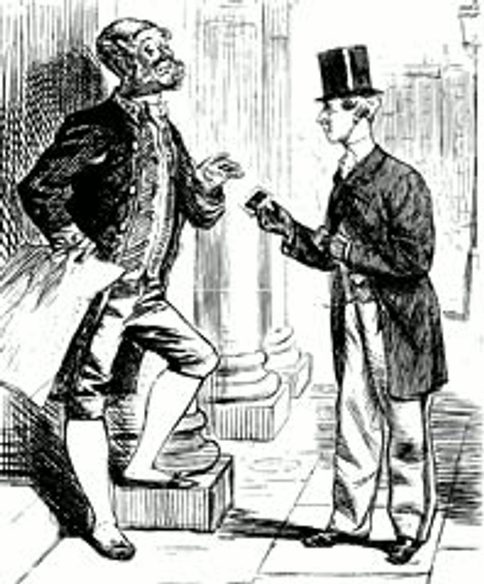
To the unrefined or unbred, the visiting card is but a trifling and insignificant bit of paper; but to the cultured disciple of social law, it conveys a subtle and unmistakable intelligence. It’s texture, style of engraving, and even the hour of leaving it combine to place the stranger, whose name it bears, in a pleasant or a disagreeable attitude even before his manners, conversation, and face have been able to explain his social position. -Our Deportment
In the 19th and early 20th century, social interaction was a richly cultivated, well-mannered affair. The tool that facilitated these interactions was the calling card. Calling cards streamlined introductions and helped remind people of new acquaintances and needed visits. The calling card also served as a way to brand your social identity. The way your card looked and felt or the way you handed it to someone communicated your standing and relationship with the receiver. While the calling card had gone the way of top hats and knickers, they’re starting to make a comeback. What follows is a brief history of the calling card and how men today can resurrect this tradition to create some stylish panache in their social interactions.
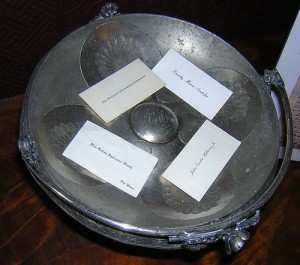 During the 1800’s and early 1900’s the practice of “calling” upon or visiting one’s relatives, friends, and acquaintances was a middle and upper class social ritual governed by countless rules and traditions. Central to visiting etiquette was the use of the calling card. Every gentleman kept a ready supply of calling cards with him to distribute upon his visits. When calling upon a friend, a gentleman gave his card to the servant answering the door. The servant would be holding a silver tray and the card would be placed upon it. If the person the gentleman was calling upon was home, the servant would take the card to them and they would come meet the gentleman. If the person being called upon was not home, the servant would leave the card for when they returned.
During the 1800’s and early 1900’s the practice of “calling” upon or visiting one’s relatives, friends, and acquaintances was a middle and upper class social ritual governed by countless rules and traditions. Central to visiting etiquette was the use of the calling card. Every gentleman kept a ready supply of calling cards with him to distribute upon his visits. When calling upon a friend, a gentleman gave his card to the servant answering the door. The servant would be holding a silver tray and the card would be placed upon it. If the person the gentleman was calling upon was home, the servant would take the card to them and they would come meet the gentleman. If the person being called upon was not home, the servant would leave the card for when they returned.
Generally upon a gentleman’s initial visit to a home, he would simply leave a card and then depart. If the new acquaintance wished to formally visit with him, he or she would send a card in return. If no card was sent, or the return card was sent in an envelope, this signaled that the new acquaintance did not wish for a personal visit to occur. This signal (the card in an envelope) could indeed be sent after any visit in which the visited party no longer wished to be called upon by this particular person. It was basically the well-mannered brush off. A calling card was also used when a gentleman was desirous to see someone at a hotel or parlor. He would send up his card while he waited in the reception area or office for his acquaintance or business associate to come and greet him.
A man’s calling card was simple and plain in design. About the size of a playing card (they were toted about in a carrying case tucked in one’s breast pocket), they bore a man’s name, and later on, his address as well. The name was written in the center, sometimes with a middle initial and sometimes not. A young man did not preface his name with “Mr.” A military officer included his rank and branch of service. A physician could include his professional title, as in “Dr. Robert Smith,” or “Robert Smith M.D.” But honorary titles such as Prof., Hon., and Esq. were not acceptable. The card sometimes also included the name of the gentleman’s club or fraternal organization a man belonged to.
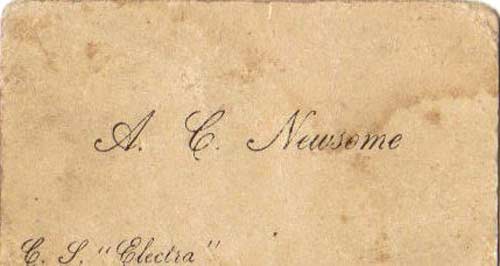
A man might have a set of calling cards that included his address and a set that left that space blank. This latter type of card would be larger and engraved with fancier writing. The blank space would be used for written notes inviting a friend to dinner or the theater or some other social event.
An engraved card was considered to have the most distinguished style, followed by a handsomely handwritten one, and if these could not be obtained, a nicely printed card would do. The precise rules governing card giving and the style of the card, from the type of font to whether to include your middle initial or not, changed each year and could leave a person a bit anxious about what was currently in fashion.
The giving and receiving of calling cards developed a very elaborate set of rituals and rules that every gentleman tried to master. While one’s modern sensibilities might find these rigid formalities laughable, I’ve got to say there’s a certain appeal to it. Far more dignified than poking someone on Facebook, wouldn’t you say?. Just in case you step through a time warp and land in the 19th century, here’s your calling card etiquette survival guide.
Special significance was given to the turning down of the card’s corners:
Gentleman would also inscribe initials upon the card to denote the reason for his visit. The initials stood for the following French words:
Card etiquette regarding certain occasions
For congratulations
Congratulatory cards were best given in person, but it was acceptable to send a card in lieu of an actual visit. One month after the birth of a child, acquaintances were to call to offer their congratulations.
For weddings
If you couldn’t attend the reception you would send a card and then wait until the couple announced the place of their new residence to send another or make a visit. But in the meantime you were expected to call upon the parents or relatives who had given the reception.
When a man’s wedding only included his family and closest friends, he would send his bachelor’s card, enclosed in an envelope to those of his acquaintances with whom he wished to remain friends. Those who received this card were expected to call on the couple within 10 days of them taking possession of their new home.
After a wedding, the friends of the bride and groom were expected to send their calling cards to the new couple. In this way, the couple would have all of their friends’ contact information on file and would be able to stay in touch with them.
Cards of Condolence
When someone passed away, acquaintances would send a card of condolence, which as mentioned, was indicated by folding down the left hand lower corner of your usual card. This card was delivered in person and the visitor would inquire after the health of the family before departing. When the bereaved once more felt up to receiving visitors, they would send cards to the friends and loved one who had left theirs, indicating their readiness to again visit with company.
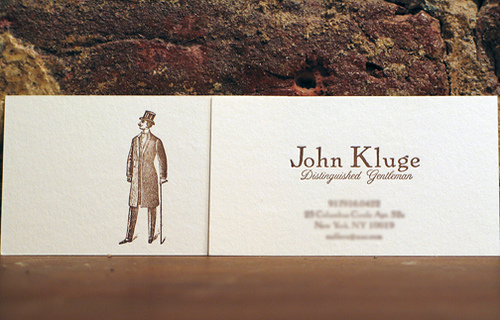
When the household servants moved out, and Alex Bell’s new fangled talking machine moved in, the practice and etiquette surrounding the sending and receiving of calling cards suffered a slow death. The only place where calling cards survived was in the U.S. Armed Forces. Officers still carry on the tradition today. But quite happily for the modern day gentleman, they are now making a comeback in civilian life as well.
While technology has opened up a legion of ways to communicate these days, something within us still craves the transfer of something tangible, something more civilized and refined.
Enter the calling card.
Why not just use a business card?
During the heyday of calling cards, using a business card for a social purpose was considered bad manners. Today, while business cards are great for making business contacts, they still aren’t really suited for social situations. They probably have your work number and work email, and not much else on them. Think of all the times you meet someone you’d like to see again. Handing them a business card is too stiff and formal. Ditto for simply having them put your digits into their phone.
Oftentimes when meeting someone, the connection you establish is too new for your acquaintance to feel comfortable calling. Perhaps before pursuing more contact, they’d like first to check out your Facebook page or blog or send you an email. And how many times in a conversation does someone tell you about their website or their blog, and you swear to check it out, but then can’t remember its name when you get home? A calling card is the answer to all of these situations. A calling card can tell a new acquaintance more about you and help them better remember you. It provides a chance to enhance the first impression you make and gives your new acquaintances the ability to pursue a relationship with you in the way they feel most comfortable.
As aforementioned, during the heyday of calling card use, the design of men’s calling cards were fairly spartan, just name and address. Today it is more acceptable to create a calling card design that gives you a chance for a bit of self-expression.
How to design a card
Your calling card should reflect your personality. When someone puts your phone number into their cell, they may look at this entry some time later and fail to remember much about you. A calling card should include something to jog their memory (although in truth, currently simply giving someone a calling card should render you fairly unforgettable). Pick a color scheme, font, and design that convey something about you. But do remember, you’re still a gentleman, not a lady, so don’t make it too flowery or cartoony. You may still opt for simply having a traditional, plain card with only your name on the front. This of course, would likewise say much about your personality.
What to include on the card
To call upon a friend in the Victorian age, there was only one option-drop by their house. In our modern society, technology has provided a myriad of ways for a new acquaintance to contact you, and your card should reflect this. In addition to your name and phone number, consider including some (but certainly not all-you don’t want it to be cluttered) of the following pieces of information:
If you decide to go for a very traditional man’s design with only perhaps your name on the front, you can then tailor the information you wish to give to each individual you meet by simply writing on the back and making the desired additions.
Calling Card Design Ideas
Vintage inspired calling cards
Modern version of the calling card
Steampunk inspired calling card

A freaky, but effective calling card.
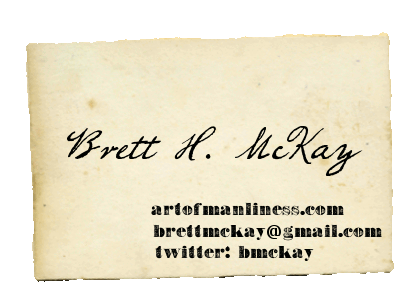
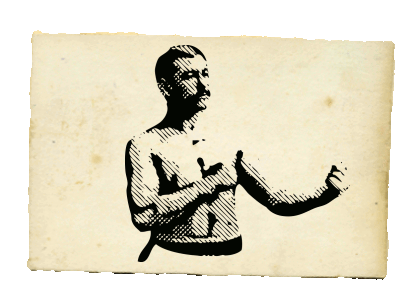
Art of Manliness calling cards

A calling card can come in handy in any social situation in which you want to exchange information with someone. Remember, you may use the blank back of the cards to write notes and invite someone to meet up with you again. For example, you might write, “Join me for coffee this Saturday, 3:00pm. Starbucks on 51rst and Harvard.” Or use the back to invite someone over for dinner and write down your address for them. Here are some more situations where a calling card would particularly come in handy:
Here are a few sites that offer calling cards that will appeal to the modern gentleman. Most will send you a sample before you buy, so you won’t be stuck with something you don’t like.
Crane & Co. (Nice, quality cards, priced between the low and high end)
The Stationery Studio. (Big selection, many are designed for women but there are many for men too, decently priced)
American Stationery (Only one design to choose from, but inexpensive)
Dempsey and Carroll (For the traditional gentleman with exquisite taste. Dempsey and Carroll have been in the biz since 1878. Very high quality. Very expensive. Custom made to your specifications.)
Piccolo Press (For our friends across the pond. Piccolo press still prints and engraves their cards the old fashioned way.)
For the frugal gentleman, or the man who doesn’t mind sacrificing quality for variety, you may wish to consider simply buying a box of business cards from Office Depot, downloading a business card template, and then printing them at home. They’ll be flimsy of course, but you can forever tinker with the font and design, and print new ones off that will especially suit a particular occasion.

I just returned from witnessing 17 days of competition at my ninth Summer Olympics. To say it was memorable is an understatement. I watched Michael Phelps win his record eight gold medals, cheered on the "Redeem Team" to basketball gold, shared the excitement of the electrifying upset win by the men's volleyball team, and witnessed the best opening and closing ceremonies in history.
What struck me throughout is what goes into making an Olympic champion—or for that matter a gold-medal winning entrepreneur or manager. Here's my short list:
Mackay's Moral: Go for the gold in whatever you do!
Babysitters earn an average $5.37 an hour in 2008. The going rate in the 1980s was $3.00, says C&R Research. 48% of drivers aged 18-24 admit to texting while driving, according to legal information Web site Findlaw.com. |
Half of 13-19 year olds have considered becoming a teacher (49%), 42% have thought about joining the military, 33% about serving in government, and 20% have thought about running for public office, according to Horatio Alger Association | |
About a third of those younger than age 25 (34%) say they get no news on a typical day, up from 25% in 1998, according to the Pew Research Center. | |
70% of teens use their cell phones to take photos and videos, an 11 point increase over 2006, reports Sulake, parent company of virtual world Habbo Hotel. |

A front-page story in USA Today got me thinking back to my youth and all the lessons I learned in my various summer jobs. The newspaper asked dozens of executives in major corporations about their first jobs and what they learned, as well as how they helped them in their careers.
The unanimous answer was all worked as teens and several of them before age 11. Many talked about hard work and the need to finish college.
Outback Steakhouse founder Tim Gannon said he has yet to meet a successful person who didn't have a great story about starting at the ground floor. "Great success comes from overcoming adversity," he said. "Without desire, you can't get to ambition."
Borders Group CEO George Jones talked about his 17-year-old son Dylan, who has not worked but rather has traveled extensively and visited more than 30 countries. "Travel is a learning experience that benefits kids greatly, and in all fairness to my son, we have made travel a higher priority than his having a job," said the elder Jones.
My parents were much the same. They encouraged me to travel as much as I could, but on my dime. When I was in high school I toured the western United States with two buddies. Then at age 21, we went to Europe and visited 16 countries. I'm still profiting from these trips.
Today's teens should think of every job opportunity as an important building block in life, no matter how menial it seems, according to Chris Kearney, CEO of industrial products giant SPX Corp. "A successful career is built incrementally, one step at a time."
I've always said your first job on any job is to learn. Donald Trump says: "Learn all you can. Try to view your job comprehensively as if it were your own business. Ask yourself: 'What kind of employee would I like to have?' Be that kind of employee."
Growing up, my father insisted there was no substitute for working odd jobs during summer vacations and Christmas holidays. I had a variety of short stints, from setting pins at a bowling alley to delivering newspapers to working at a golf course. In high school, I landed a neat job at a downtown St. Paul men's clothing store.
Now, peddling pants, socks, underwear, ties, hankies and occasionally a shirt or two may not sound like the most glamorous position in the world, but in retrospect, it was a great job. At a young age, I had an opportunity to learn about business, have a boss to report to, show up for work on time, handle money and credit, understand how customers shop and learn a little about the retail clothing industry. My boss, Chris, hammered these principles into my brain bank:
This is the short list. Looking back, probably the greatest plus of the job was, whether I realized it or not, I was polishing my sales skills at a very early age.
When you are young, footloose, and fancy free, you don't have a care in the world. You are always in the "comfort zone." You don't quite realize the responsibility of holding down a legitimate job. Better said, you don't realize the importance of holding down a job legitimately.
Mackay's Moral: What you learn on your first job will last through your last job.
![]()
Miss a column? The last three weeks of Harvey's columns are always archived online.
More information and learning tools can be found online at harveymackay.com.

By MICHAEL LIEDTKE
AP TECHNOLOGY WRITER
SAN FRANCISCO -- Google Inc. is trying to expand the newspaper section of its online library to include billions of articles published during the past 244 years, hoping the added attraction will lure even more traffic to its leading Internet search engine.
The project announced Monday extends Google's crusade to make digital copies of content created before the Internet's advent, so the information can become more accessible and, ultimately, Google can make more money from ads shown on its Web site.
As part of the latest initiative, Google will foot the bill to copy the archives of any newspaper publisher willing to permit the stories to be shown for free on Google's Web site. The participating publishers will receive an unspecified portion of the revenue generated from the ads displayed next to the stories.
Google is touting the program as a way to give people an easier way to find a rich vein of history. The initiative also is designed to provide a financial boost to newspaper publishers as they try to offset declining revenue from print editions that are losing readers and advertisers to online news sources.
"I believe this could be a turning point for the industry," said Pierre Little, publisher of the Quebec Chronicle-Telegraph, which touts itself as North America's oldest newspaper, with editions dating to 1764. "This helps us unlock a bit of an asset that had just been sitting within the organization."
Besides the Chronicle-Telegraph, other newspapers that have already agreed to allow Google to copy and host their archives include the Pittsburgh Post-Gazette and the St. Petersburg Times in Florida. Google declined to specify how many other papers have signed up or how much the company has budgeted for the project.
Google already has committed to spending tens of millions of dollars to make electronic copies of books and other material kept in dozens of libraries around the world. The book-copying program, launched in 2004, has triggered a lawsuit from group of authors and publishers that alleges it infringes on copyrights - a charge that Google is fighting.
Major newspapers including The New York Times and The Washington Post began to give Google's search engine access to some of their electronic archives in 2006. But those results frequently displayed only news snippets. Readers often had to pay a fee to see the entire article.
Besides being free, the newspaper archives hosted by Google will be presented in the same way they originally appeared in print, said Adam Smith, Google's product management director.
Finding the old newspaper stories initially will require searching through Google's "news" or "news archive" section. The newspaper archives should start showing up on Google's main results page within the next year, Smith said.
---
Photo from aroundfortwayne.com

By Howard Kurtz
Washington Post Staff Writer
Monday, September 8, 2008; C01
MSNBC is removing Keith Olbermann and Chris Matthews as the anchors of live political events, bowing to growing criticism that they are too opinionated to be seen as neutral in the heat of the presidential campaign.
David Gregory, the NBC newsman and White House correspondent who also hosts a program on MSNBC, will take over during such events as this fall's presidential and vice presidential debates and election night.
The move, confirmed by spokesmen for both networks, follows increasingly loud complaints about Olbermann's anchor role at the Democratic and Republican conventions. Olbermann, who regularly assails President Bush and GOP nominee John McCain on his "Countdown" program, was effusive in praising the acceptance speech of Democratic nominee Barack Obama. He drew flak Thursday when the Republicans played a video that included a tribute to the victims of the Sept. 11 attacks, saying that if the networks had done that, "we would be rightly eviscerated at all quarters, perhaps by the Republican Party itself, for exploiting the memories of the dead, and perhaps even for trying to evoke that pain again. If you reacted to that videotape the way I did, I apologize."
Matthews, who has criticized politicians in both parties, drew less criticism for his convention role but became a divisive figure during the primaries when he described how he was inspired by Obama's speeches and made disparaging remarks about Hillary Clinton, for which he later apologized.
In May, MSNBC President Phil Griffin said in an interview that during live events Olbermann and Matthews "put on different hats. I think the audience gets it. . . . I see zero problem."
But NBC News journalists, who often appear on the cable channel, did see a problem, arguing behind the scenes that MSNBC's move to the left -- which includes a new show, debuting tonight, for Air America radio host Rachel Maddow -- was tarnishing their reputation for fairness. Tom Brokaw, the interim host of "Meet the Press," said that at times Olbermann and Matthews went too far.
Olbermann and Matthews will remain as analysts during major political events, and officials at both networks, who declined to be identified discussing personnel moves, said Olbermann had initiated the discussions to clarify his role. They said Olbermann's influence at MSNBC would in no way be diminished and that the shift would enable him and Matthews to offer more candid analysis during live coverage. Olbermann confirmed yesterday he had initiated the discussions.
"Phil and I have debated this set-up since late winter/early spring (with me saying, 'Are you sure this flies?' and him saying, 'Yes, but let's judge it event by event') and I think we both reached the same point during the RNC," Olbermann said by e-mail.
Olbermann was involved in several on-air incidents during the conventions that drew unwanted attention. He told morning host Joe Scarborough, a former Republican congressman, to "get a shovel" as Scarborough was defending the McCain campaign. And when GOP strategist Mike Murphy was debating Matthews, Olbermann could be heard saying, "Let's wrap him up."
These and other clashes fueled a sense that conservative voices are less than welcome at MSNBC as it has tried to position itself as a left-wing alternative to Fox News Channel. Olbermann disputes this view, calling the incidents "overblown." Still, the network canceled Tucker Carlson's show in March and has diminished his role. And Dan Abrams, the veteran NBC legal analyst and former MSNBC general manager, had his program dropped last month to make room for Maddow, an Olbermann protege.
MSNBC's more liberal outlook has boosted its ratings, though it remains the third-place cable news channel. But both parties began castigating its coverage last spring. Steve Schmidt, McCain's top strategist, called the network "an organ of the Democratic National Committee," and Clinton campaign chairman Terry McAuliffe said Matthews was "in the tank" for Obama.



The 43-year-old actress said in addition to her two main life recommendations, others should remember to floss their teeth and avoid stress if they want to have a happy life, People magazine reported Friday.
"Have great sex (and) eat the chocolate," the single mother-of-one said.
"Don't sit on public toilet seats and make sure to floss … . Life's too short to stress; you'll be able to get past anything difficult; the sun will rise tomorrow; you are beautiful; you are lovable."
People said the admittedly cynical actress said she maintains a to-do board in her home that helps her maintain a healthy and happy lifestyle.
"Against all my well-honed cynical beliefs; it's actually working," Hatcher said of her goal-oriented list.
How To Make Your To-Do List Work For You
Posted: 04 Sep 2008 08:05 AM CDT
 | Written on 9/04/2008 by Ali Hale who writes about healthy eating for busy people at her blog, The Office Diet. | Photo Credit: Jayel Aheram |
 Whether you’re a student, employee, or freelancer, chances are that you’ve come across lots of advice recommending that you use a to-do list. At its simplest, a to-do list is just a series of tasks that you want to get done today – but there are dozens of variations on this theme.
Whether you’re a student, employee, or freelancer, chances are that you’ve come across lots of advice recommending that you use a to-do list. At its simplest, a to-do list is just a series of tasks that you want to get done today – but there are dozens of variations on this theme.
The Internet has changed the world profoundly. We use it everyday. But how much do you know about its history?
The National Science Foundation funds and supports research in many fields. It played an integral part in the creation of the Internet.
The NSF has put the story of the Internet online. You'll learn about the key innovations that shaped the Internet of today.
The story is broken up by decade, starting with the 1960s. You'll see interviews with the people involved at every stage.
Internet experts will also tell you what to expect for the future. If they're right, it's going to be a very interesting place.
TO VISIT TODAY'S COOL SITE, GO HERE:
www.nsf.gov
Copyright © 2008, The Kim Komando Show. All rights reserved. Newsletters may contain links to sites on the Internet owned and operated by third parties. The Kim Komando Show is not responsible for the availability of, or the content located on or through, any such third-party site. Information in this document is provided "as is" without warranty of any kind, either expressed or implied, including but not limited to the implied warranties of merchantability, fitness for a particular purpose and freedom from infringement. The user assumes the entire risk as to the accuracy and the use of this document. We will not be liable for any damages of any kind arising from the use of this information, including, but not limited to direct, indirect, incidental, punitive, and consequential damages.